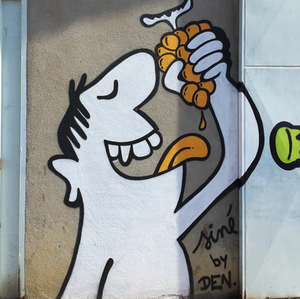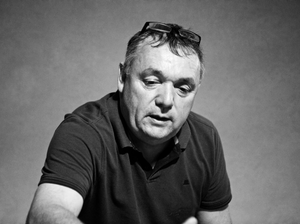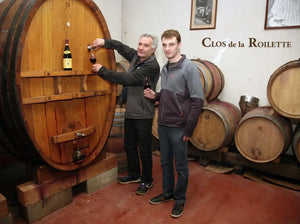Blog » Beaujolais
-
Fleurie Rising: 2021 Yann Bertrand Beaujolais
Cru Beaujolais has been a cornerstone of our selection from the start. While Foillard, Métras, Lapierre, and Dutraive represent the foundation for the greatest value reds in France, the younger generation is now clearly making its mark. Yann may be separated from the aforementioned because of age, but when you line up his wines, it's crystal clear these are commanding interpretations of terroir.
Yann grew up in Fleurie, but after studying commerce in school and traveling through the Alps, he never expected to circle back to become its generation's brightest talent. He found himself working in a wine shop, and surrounded by passionate people, the flames of curiosity were stoked. He spent time working under perhaps the region's most revered names: Yvon Métras and Jean Foillard. Like them, Yann knew that organic farming and traditional methods in the cellar would be his path forward.
In 1992, Yann's family purchased vineyards and slowly converted them to organic farming. Yann took a more active role in leading the domaine in 2013, and he began applying what he had soaked up from his apprenticeships. Similarly, Yann's style is one of elegance, silken texture, and laser focus, expressing each unique terroir in the Famille Bertrand stable. -
The Last Chapter of Beaujolais: Métras Fleurie
When I travel to France there's always one producer I crave to drink, Yvon Métras. The Fleurie-based vigneron is famous for spellbinding and pillow-soft Gamay with a magic touch of complexity often calling to mind Grand Cru Burgundy before Beaujolais. That's obviously a bold statement, but I've lost count of the times this thought struck me upon first sip. When the wines are on, there is nothing that hits the same high. Unfortunately, Yvon is equally famous for his disdain of paperwork, and so the wines that once were regularly imported to the US have, more or less, stopped. Today, I'm very happy to offer a wide range that I've slowly been collecting, including a rare four-bottle vertical of his flagship, Fleurie.
Métras Fleurie is sourced primarily from two celebrated vineyards, La Madonne and Grille Midi. The former named for the church built on top of the steep hill, and the latter loosely translating to "roasts at noon", as this site garners substantial afternoon heat. Both parcels in these two vineyards are even more prized due to Yvon's collection of vines that top 120-years of age.
Métras, like Foillard and Lapierre, was heavily influenced by the teachings of Jules Chauvet. Organic viticulture, native yeast ferments, and no sulphur additions. Yvon follows traditional whole cluster, semi-carbonic fermentation in concrete tanks prior to raising in neutral oak.
If you, like me, have ever had that epiphany moment with Beaujolais where the subtle, but brilliant, conviction of the wines strikes a chord, then Métras is akin to the ultimate, final discovery.
The Queen of Beaujolais, Fleurie is built around silken texture, pure red cherry and strawberry tones, and finely-woven granitic lacing. Where the Métras wines seem to go above and beyond even his greatest contemporaries is their gripping saturation and relentless finish, still gathering like a cloud on the palate. For Métras, much of the magic is in what we'll never learn, what's unable to be revealed through methods in the cuverie or the vineyard.. And it's this mystery that makes the experience that much more exhilarating to discover for yourself. -
2023 Lapierre Raisins Gaulois: Epitome of Spring Fresh
Of all the glou-glou wines in France, Lapierre's Raisins Gaulois perfectly suits this funny badge. Glou-glou is the sound of wine leaving the bottleneck when poured rapidly and the sound of one's gulping. Lapierre may turn out dead serious Morgon, but this Beaujolais from young vines is released early to harness all the plump and delicious Gamay fruit with pricing that makes it easy to stock up on.
Nearly all of the vines tapped for Raisins Gaulois comes from within the esteemed cru of Morgon, with small amounts of fruit from the larger Beaujolais appellation. Like all Lapierre wines, this is from organically farmed land, fermented with native yeasts and whole clusters. These young vines provide that fruit-forward, rambunctious, and unctuous Gamay grapey personality (Yes, that's an apt descriptor).
Marcel took over his father's domaine in 1973. Then, his encounter with Jules Chauvet in 1981 launched a shift toward natural viticulture and winemaking in Beaujolais. Along with Jean Foillard, Guy Breton, and Jean-Paul Thévenet, the Gang of Four's practices spread quickly, yielding wines of authenticity and joie de vivre. Since 2010, Marcel's children Matthieu and Camille have carried on the natural approach that placed their father in the hearts of winemakers and enthusiasts across the globe.The warm 2023 season is a perfect fit for this red. And, as always, it's best served with a chill. -
Jean-Louis Dutraive: Fleurie's Bright Light
Jean-Louis Dutraive's entire stable of wines falls into the elite category of Cru Beaujolais. While he has various parcels in Fleurie, the Clos de la Grand Cour always thrills me for its lightness and ethereal pitch.
The Clos de la Grand Cour is a true walled-in vineyard, with up to 80-year-old vines growing on almost pure granite with a thin topsoil. The wine ages 35% in stainless steel, 30% in fûts de chêne, and 30% foudres for 9 to 12 months. Lifted spices meet fresh raspberry and cherry to give a delicate wine with a deep texture and a long finish.
The old-vine cuvée, Le Clos, takes the concentration and intensity up with darker red fruits and penetrating salinity. With its deeper soils, the Chapelle des Bois gives a more satiny texture with less incisive minerality. And the Brouilly shows a more muscular side of Dutraive's still charming and approachable form.
Compared to other titans of Beaujolais, I find Dutraive's wines are often lighter in color, with more lifted spice and a wild, natural element that stands out due to a low sulfur protocol. I try to wait several years after release to tap into these top cuvées. Aged Dutraive is pure magic when fruit begins to fall to the background, and exotic spices become more prominent.
The 2022s are a giant success at this address and prove that Jean-Louis is still one of the benchmarks of the Beaujolais.Photo by Ted Vance
-
Fleurie Benchmark: Clos de la RoiletteBy nature, most Gamay-based wines from the Beaujolais are opened within a year of release, but the wines of the Coudert family are best known for their unrivaled complexity and track record for aging.One year, at La Paulée's verticals tasting, 31 tables were filled with the best of Burgundy (Roumier, Lafon, Rousseau, Mugneret-Gibourg, D'Angerville) and one sole Cru Beaujolais (Roilette). Set alongside Burgundy's most elite producers, the tasting was a great reminder that the best of Cru Beaujolais greatly rewards the patient.The story of Roilette's evolution is a fascinating one. The vineyards were historically classified as Moulin-à-Vent, and its owners are proud of that designation. But in the 1920s, districts were re-drawn, and the Fleurie appellation was created. This newfound appellation, which was required to appear on the label, enraged the owner of the Clos de Roilette. Instead of printing Fleurie, he used a photo of his racehorse and refused to sell his wines in France, exporting 100% of his production to neighboring countries.In 1967, ownership changed hands, and this largely untended vineyard went into the thoughtful stewardship of Fernand Coudert. Today, the wines are widely regarded as the benchmark of not only Fleurie but the entire Beaujolais region.The border of Moulin-à-Vent and Fleurie, where the estate sits, is home to clay-dominant vineyards. Whereas most of Beaujolais is on granite, the clay and manganese soils of Roilette give a darker and richer expression of Gamay. Blue and black fruits are abundant in all of the estate's wines.Roilette's Fleurie bottling comes from a parcel of 30-to-45-year-old vines and undergoes the same whole cluster, semi-carbonic fermentation regimen as the estate's Cuvée Tardive and Griffe du Marquis. Stylistically, the Fleurie is open-knit and has a more supple tannin structure, still with the stuffing to age gracefully and develop over the next few years.
.svg?v=162776257677185172071724397232)







